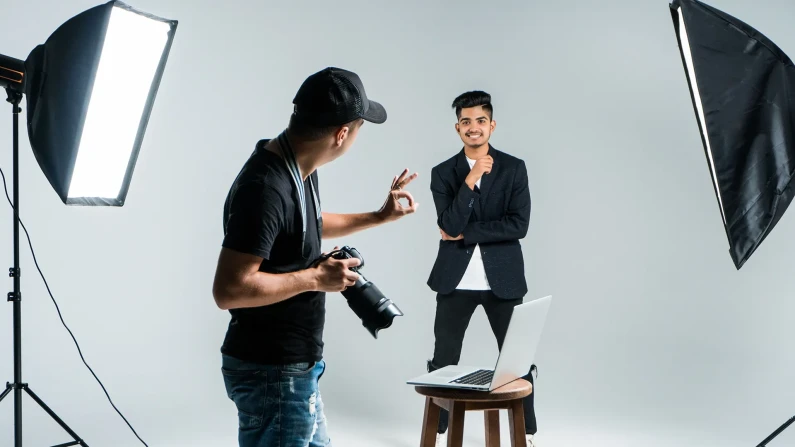Why You Should Hire a Professional Photographer (and not just use your smartphone)

From a Graphic Designer Who’s Seen It All...
In a world where nearly everyone has a smartphone and thousands of photos sitting in their pocket, it’s tempting to think: “Why hire a professional photographer when I can just take the photo myself?”
As a graphic designer with decades of experience creating everything from brochures to websites to billboards, let me gently (but firmly) explain why that thinking might cost your business more than it saves.
1. Smartphones are Smart – but they're not that Smart
Yes, smartphones today are amazing. They’re getting better every year, packed with clever software to adjust lighting, focus, and exposure. But here’s the thing: smartphone cameras are designed for ‘point and click’ convenience, not control. They’re built to make an ‘OK’ photo look decent, not to capture a technically ‘perfect’ image.
When I receive smartphone photos from clients, I can usually spot them a mile off. The lighting’s a bit off, the perspective is skewed, and the resolution falls apart when I try to enlarge it for print. That ‘quick snap’ might be good enough for your personal Instagram, but it just won’t cut it in a professionally designed marketing campaign.
2. Professional Photographers know lighting like Designers know typefaces
One of the key differences between a smartphone pic and a professional image is lighting. A photographer understands light – how to shape it, soften it, block it, or enhance it.
Photographers don’t rely on the sun behaving, or fluorescent lights playing nice. They bring lighting gear, reflectors, diffusers, and a solid dose of technical knowledge to make you, your products, or your workspace look their absolute best.
Smartphones rely on automatic settings. A pro knows when to override the camera and how to work with difficult environments – backlighting, mixed temperatures, low-light scenes. These are things a phone can’t always fix.
3. Composition and Creativity are Skills, not Filters
There’s more to photography than pointing and shooting. A professional photographer frames every shot with purpose. They think about background, depth, leading lines, symmetry, context, and mood. They know when to shoot tight and when to go wide. They don’t cut off someone’s head in a group shot or photograph your product from an unflattering angle.
And when you’re working with a designer (like me), that creative eye makes a massive difference. High-quality, well-composed photos give us more flexibility with layout. We can crop, overlay text, knock out backgrounds, or pull details from the image without losing integrity. A poorly composed image often leaves us stuck or forced to design around its limitations.
4. Image Quality Matters (especially for print)
Here’s where it gets serious. Smartphone photos are typically 72 DPI (dots per inch), suitable for screens. But for printed materials like flyers, signage, banners, or brochures, you need 300 DPI or more. A blurry or pixelated image is a dead giveaway that shortcuts were taken. And once it’s in print, you can’t hide behind filters.
I’ve lost count of how many times a client has handed me a smartphone photo they want to use for a poster, only for it to fall apart when scaled. A professional photo, by contrast, will be taken with high-resolution equipment and exported in print-ready formats, ensuring your final product looks sharp, vibrant, and credible.
5. Brand Image = Business Value
Your images are an important part of your brand. They’re the first thing a potential customer sees, and whether they consciously realise it or not, they’re forming an opinion based on them. Poor lighting, awkward angles, blurry edges – all of these subtly communicate a lack of professionalism.
If you’re investing in quality graphic design, why undermine it with amateur photography? When a client sends me beautiful, professionally shot images, I breathe a sigh of relief. It makes everything, from layouts to colour matching, fall into place. The end result is polished, cohesive, and persuasive. It tells your audience: “We’re the real deal.”
6. Time is Money – and Professionals save you both
Yes, hiring a professional photographer is an added expense, but it actually saves both time and money in the long run. A pro knows how to work efficiently, deliver what’s needed, and provide a library of images that can be used across multiple channels. They take the pressure off you to “get the shot,” edit the image, and try to make it look professional.
And let’s be honest – how many times have you spent hours fiddling with a phone photo, only to still be unhappy with the result? How many times have you gone back and re-shot something because the original image just didn’t cut it?
That’s valuable time that could have been used to actually run your business.
7. Professionals bring Consistency
A skilled photographer will deliver a consistent look across your photos – consistent lighting, colour grading, framing, and tone. This visual cohesion is gold for designers like me. It ensures that your marketing materials feel unified, whether they’re online or in print. When the tone and quality of your photos are all over the place, no amount of clever design can hide it.
8. The Collaboration is Worth it
Finally, there’s the creative chemistry that happens when professionals collaborate. I often work directly with photographers to plan shoots that will align with design needs – horizontal vs vertical orientation, room for text, product positioning, colour themes, etc. That level of coordination just isn’t possible when you’re winging it with your phone.
The Bottom Line
Hiring a professional photographer isn’t about being fancy. It’s about showing your business in the best possible light (literally and figuratively). Great design relies on great content – and that starts with great images.
So next time you’re tempted to whip out your phone and take a snap for your website or brochure, pause. Think about how that photo will represent your business. And then, seriously, call a pro.
You’ll thank yourself later (and so will your designer).
